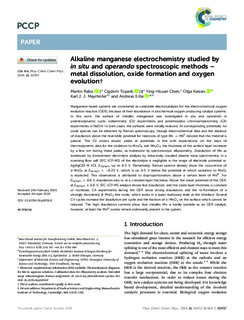| dc.contributor.author | Rabe, Martin | |
| dc.contributor.author | Toparli, Cigdem | |
| dc.contributor.author | Chen, Ying-Hsuan | |
| dc.contributor.author | Kasian, Olga | |
| dc.contributor.author | Mayrhofer, Karl J.J. | |
| dc.contributor.author | Erbe, Andreas | |
| dc.date.accessioned | 2019-08-20T10:41:28Z | |
| dc.date.available | 2019-08-20T10:41:28Z | |
| dc.date.created | 2019-05-22T14:31:14Z | |
| dc.date.issued | 2019 | |
| dc.identifier.citation | Physical Chemistry, Chemical Physics - PCCP. 2019, 21 10457-10469. | nb_NO |
| dc.identifier.issn | 1463-9076 | |
| dc.identifier.uri | http://hdl.handle.net/11250/2609287 | |
| dc.description.abstract | Manganese-based systems are considered as candidate electrocatalysts for the electrochemical oxygen evolution reaction (OER), because of their abundance in biochemical oxygen producing catalyst systems. In this work, the surface of metallic manganese was investigated in situ and operando in potentiodynamic cyclic voltammetry (CV) experiments and potentiostatic chronoamperometry (CA) experiments in NaOH. In both cases, the surfaces were initially reduced. At corresponding potentials, no oxide species can be detected by Raman spectroscopy, though electrochemical data and the absence of dissolution above the reversible potential for reactions of type Mn → MnII indicate that the material is passive. The CV shows anodic peaks at potentials in line with expectations on the basis of thermodynamic data for the oxidation to Mn3O4 and Mn2O3; the thickness of the surface layer increases by a few nm during these peaks, as evidenced by spectroscopic ellipsometry. Dissolution of Mn as evidenced by downstream electrolyte analysis by inductively coupled plasma mass spectrometry in a scanning flow cell (SFC-ICP-MS) of the electrolyte is negligible in the range of electrode potential vs. Ag|AgCl|3 M KCl, EAg|AgCl, up to 0.3 V. Remarkably, Raman spectra already show the occurrence of α-MnO2 at EAg|AgCl > −0.25 V, which is ca. 0.5 V below the potential at which oxidation to MnO2 is expected. This observation is attributed to disproportionation above a certain level of MnIII. For EAg|AgCl > 0.4 V, dissolution sets in, at a constant layer thickness. Above the onset potential of the OER, at EAg|AgCl ≈ 0.6 V, SFC-ICP-MS analysis shows fast dissolution, and the oxide layer thickness is constant or increases. CA experiments during the OER show strong dissolution, and the re-formation of a strongly disordered, β-MnO2-like oxide, which exists in a quasi-stationary state at the interface. Several CV cycles increase the dissolution per cycle and the fraction of α-MnO2 on the surface which cannot be reduced. The high dissolution currents show that metallic Mn is hardly suitable as an OER catalyst, however, at least the MnIV oxides remain stationarily present in the system. | nb_NO |
| dc.language.iso | eng | nb_NO |
| dc.publisher | Royal Society of Chemistry | nb_NO |
| dc.rights | Navngivelse 4.0 Internasjonal | * |
| dc.rights.uri | http://creativecommons.org/licenses/by/4.0/deed.no | * |
| dc.title | Alkaline manganese electrochemistry studied by in situ and operando spectropscopic methods - metal dissolution, oxide formation and oxygen evolution | nb_NO |
| dc.type | Journal article | nb_NO |
| dc.type | Peer reviewed | nb_NO |
| dc.description.version | publishedVersion | nb_NO |
| dc.source.pagenumber | 10457-10469 | nb_NO |
| dc.source.volume | 21 | nb_NO |
| dc.source.journal | Physical Chemistry, Chemical Physics - PCCP | nb_NO |
| dc.identifier.doi | 10.1039/C9CP00911F | |
| dc.identifier.cristin | 1699538 | |
| dc.description.localcode | This article is licensed under a Creative Commons Attribution 3.0 Unported Licence. | nb_NO |
| cristin.unitcode | 194,66,35,0 | |
| cristin.unitname | Institutt for materialteknologi | |
| cristin.ispublished | true | |
| cristin.fulltext | original | |
| cristin.qualitycode | 2 | |

